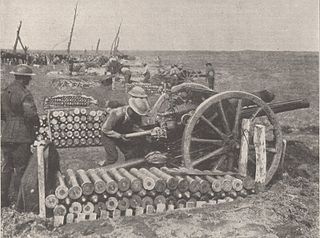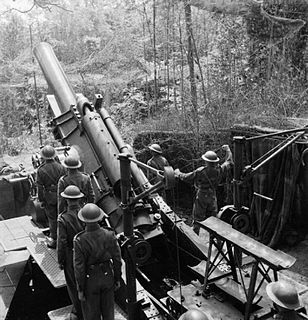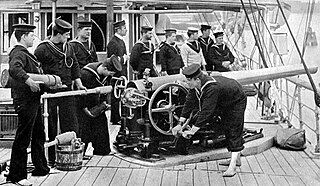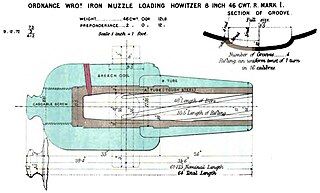
The BL 5.5 inch Gun was a British artillery gun introduced during the middle of the Second World War to equip medium batteries.
This article explains terms used for the British Armed Forces' ordnance and also ammunition. The terms may have slightly different meanings in the military of other countries.

The artillery of World War I was the trench warfare that set in shortly after the conflict commenced, and was an important factor in the war, influencing its tactics, and operations, and being incorporated into strategies that were used by the belligerents to break the stalemate at the front. World War I raised artillery to a new level of importance on the battlefield.

The BL 8-inch howitzer Mark I through to Mark V were a British improvisation developed early in the First World War to provide heavy artillery. It used shortened and bored-out barrels from various redundant naval 6-inch guns.

The Ordnance BL 12-inch howitzer was a scaled-up version of the successful BL 9.2-inch siege howitzer.
12-pounder gun or 12-pdr, usually denotes a gun which fired a projectile of approximately 12 pounds.

The 6 inch Howitzer, Model of 1908 was the standard American heavy howitzer before World War I. Forty-two of these weapons had been produced before 1917 and all were employed within the US for training in that war. Although this weapon appears in World War I-era tables of organization and equipment, for combat use in France the Canon de 155 C mle 1917 Schneider was purchased, and remained the standard weapon of this class until early World War II. All surviving weapons were retired during the 1920s.

The 15 cm schwere Feldhaubitze 1902 was a German heavy field howitzer cannon introduced in 1903 and served in World War I.

The 15 cm schwere Feldhaubitze M 94 was a heavy howitzer used by Austria-Hungary in World War I. It had a bronze barrel and relied on wheel ramps to absorb its recoil. The barrel was modified in 1899 as the M 99 and can be identified by its octagonal shape. Both howitzers could be mounted on a wide variety of carriages to suit their mission, including a carriage only 1.13 metres (44 in) wide for mountain use. Around the start of the 20th century both the M 94 and M 99 were modified to increase their elevation up to 65°. The elevation arc had to be extended and the trunnion mounts and wheels had to be strengthened to withstand the greater recoil forces when firing at high elevation. They were known as the M 94/4 and the M 99/4 after modification.

The BL 6-inch gun Marks II, III, IV and VI were the second and subsequent generations of British 6-inch rifled breechloading naval guns, designed by the Royal Gun Factory in the 1880s following the first 6-inch breechloader, the relatively unsuccessful BL 6-inch 80-pounder gun designed by Elswick Ordnance. They were originally designed to use the old gunpowder propellants but from the mid-1890s onwards were adapted to use the new cordite propellant. They were superseded on new warships by the QF 6-inch gun from 1891.

The BL 4-inch gun Mk I – Mk VI were a family of early British breech-loading 4-inch naval guns.

The 152 mm howitzer Model 1910 Schneider or, more properly, 6 dm polevaja gaubitsa sistemy Schneidera as it was designated in Tsarist times, was a French howitzer designed by Schneider et Cie. It was used by the Russian Empire and the Soviet Union during World War I, the Russo-Polish War and the Russian Civil War. Finland captured nine during the Finnish Civil War, but didn't use them during that conflict. They did see combat during the Winter War and the Continuation War.

The BL 6-inch 80-pounder gun Mk I was the first generation of British 6-inch breechloading naval gun after it switched from muzzle-loaders in 1880. They were originally designed to use the old gunpowder propellants.

The RML 8-inch howitzer was a British Rifled, Muzzle Loading (RML) Howitzer manufactured in England in the 19th century, which fired a projectile weighing approximately 180 pounds (82 kg). It was used in siege batteries and in fortifications.
This page is based on this
Wikipedia article Text is available under the
CC BY-SA 4.0 license; additional terms may apply.
Images, videos and audio are available under their respective licenses.













